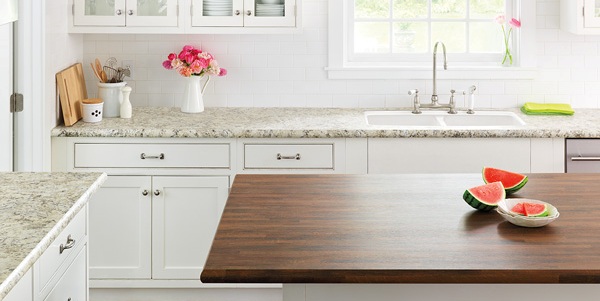Laminate Surfaces
Countertops can be made from lots of materials – solid surfacing, natural or engineered stone, even ceramic or glass tile. But if you want the best selection of colors and patterns, and the lowest price, laminate is your choice. Yet laminate’s advantages go beyond price and selection. Taking a look at these advantages will show you how favorably laminate stacks up against the high-priced competition.
Getting what you want
There are hundreds of laminate colors and patterns. (Wilsonart offers more than 250) These range from vibrant pure colors to hundreds of patterns that simulate the look of stone and wood, all at a fraction of what you’d pay for the real thing. You’ll have around 60 solid surfacing colors and patterns to pick from; one company only offers 17. It’s a little better with engineered stone, a man-made composite material using natural quartz: there about 150 choices. With granite and marble, what you get depends on what’s been quarried, and you can’t pick from easy-to-use sample chips; you have to sort though slabs at the stone yard, or just take your chances on what’s available when you order. If you want soapstone, another natural countertop material, your choice is black!
Laminate also offers more edge choices than other materials. Besides a range of rolled edges and a beveled edge, you can edge your laminate countertop with wood, or use solid surface inserts to create an eye-catching decorative edge. And only laminate can be formed into a seamless cove backsplash to keep spills from seeping behind the cabinets.
The look of laminate
Laminate countertops, like those made from granite and engineered stone, have seams where the countertop sections come together. A good fabricator can make laminate seams almost disappear. Not so easy with either natural or engineered stone countertops. And forget about it with tile countertops – both ceramic and granite. No way to do those without grout lines, and their potential for bacteria build-up.
Laminate and food preparation
Countertops come into direct contact with foods. The less porous the countertop, the less likelihood that bacteria will be trapped in the surface. Laminate performs well here, as the surface is non-porous. Solid surfaces and engineered stone countertops are non-porous as well. Natural stone and concrete need to be resealed every six months, a real nuisance. With tile countertops, the tiles are nonporous, the grout lines aren’t. Even when sealed, grout lines need to be carefully cleaned or they will become bacteria traps. Laminate is easy to clean, and spills like wine and spaghetti sauce come off will little effect
Wear and tear
Countertops are meant to be used, so expect normal wear and tear with your laminate countertop. Heat will cause the most damage. Put a hot pot on laminate, and you might leave a scorch mark. A good rule of thumb with any countertop is that if a pot is too hot to handle, don’t set it down on a countertop; use a trivet. Heat won’t hurt a granite countertop, but acid will. Leave a lemon slice on a granite countertop or spill a little vinegar, and the granite top will need to be resealed to make it safe against bacteria. Not so with laminate.
Laminate is a strong material, but it won’t resist a determined attempt to cut it with a knife. Knife cuts can go through the color layer exposing the brown underlayment. These cuts cannot be repaired, so be careful and use cutting boards. Solid surfacing can be repaired, but only by a professional. Laminate is not bullet-proof, but it can take a beating. Like tile, granite and engineered stone, if you chip it, you can’t repair it completely. But it’s a lot less expensive to replace, if the damage is severe!
The price tag
- Low initial cost.
- Easy and inexpensive to replace.

